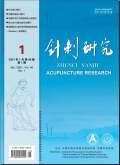针刺研究2024,Vol.49Issue(3):283-288,6.DOI:10.13702/j.1000-0607.20221402
基于"气机升降"理论经皮穴位电刺激对全麻腹腔镜胆囊切除术后患者自主神经和胃肠功能的影响
Effect of transcutaneous electrical acupoint stimulation based on the theory of"qi ascending and descending movement"on autonomic nervous system and gastrointestinal function in patients after general anesthesia laparoscopic cholecystectomy
摘要
Abstract
Objective To observe the therapeutic effect of transcutaneous electrical acupoint stimulation(TEAS)based on the theory of"qi ascending and descending movement"in patients after general anesthesia laparo-scopic cholecystectomy,so as to explore the impact of TEAS on the autonomic nervous system and gastrointestinal function of patients.Methods A total of 204 patients scheduled to undergo general anesthesia laparoscopic cholecys-tectomy were selected and randomly divided into control,double acupoints and multiple acupoints groups,with 68 cases in each group.For patients in the multiple acupoints group,TEAS was applied at Zusanli(ST36),Tiantu(CV22),Danzhong(CV17),Zhongwan(CV12),Taichong(LR3),and Neiguan(PC6)30 min before anesthesia in-duction until the end of the surgery.In the double acupoints group,TEAS was applied only at ST36 and PC6.No electri-cal stimulation was applied in the control group.The postoperative bloating,bowel sound recovery time,first farting time,first defecation time,length of hospital stay,nausea and vomiting were compared among the three groups.Heart rate variability was monitored by twelve-lead electrocardiogram to evaluate the autonomic nervous function of the pa-tients,including the low frequency power/high frequency power ratio(LF/HF),the standard deviation of all sinus RR in-tervals(SDNN),and the root mean square of difference between successive normal RR intervals(RMSSD).Results At 6 h and 24 h after surgery,the symptoms of bloating,nausea and vomiting in the multiple acupoints group and double acupoints group were significantly improved compared to the control group(P<0.05),and the multiple acupoints group was superior to the double acupoints group(P<0.05).Compared with the control group,the bowel sound recovery time,first farting time,first defecation time,and length of hospital stay were significantly shorter(P<0.05)in the multiple acupoints group and double acupoints group,and the multiple acupoints group was superior to the double acu-points group(P<0.05).At 1 d and 2 d after surgery,compared with the control group,LF/HF was decreased(P<0.05)while SDNN and RMSSD were increased(P<0.05)in the multiple acupoints group and double acupoints group,and there was a significant difference between the two groups(P<0.05).Conclusion TEAS treatment based on the theory of"qi ascending and descending movement"can relieve gastrointestinal dysfunction,reduce early postoperative sym-pathetic nerve excitement and maintain parasympathetic nerve tension in patients after general anesthesia laparoscopic cholecystectomy,thereby promoting gastrointestinal function recovery.关键词
经皮穴位电刺激/腹腔镜胆囊切除术/气机升降/胃肠功能/自主神经Key words
Transcutaneous electrical acupoint stimulation/Laparoscopic cholecystectomy/Qi ascending and descending movement/Gastrointestinal function/Autonomic nervous system引用本文复制引用
蔡元春,林雅丽,银世杰,丁艺,武伟,莫科林,石俊丹,宋慧洁..基于"气机升降"理论经皮穴位电刺激对全麻腹腔镜胆囊切除术后患者自主神经和胃肠功能的影响[J].针刺研究,2024,49(3):283-288,6.基金项目
广西壮族自治区中医药管理局自筹经费科研项目(No.GZZC2019050、GZZC2019048) (No.GZZC2019050、GZZC2019048)
广西中医药大学高层次人才培育创新团队资助项目(No.2022B007) (No.2022B007)

